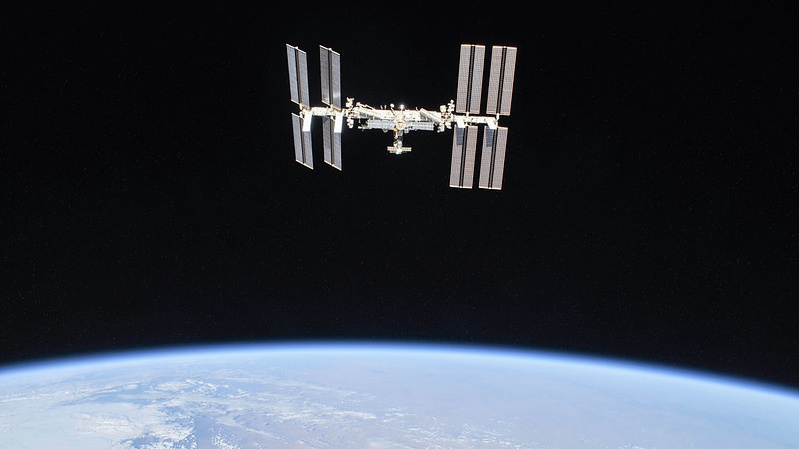Quantum chemistry experiment on ISS creates exotic 5th state of matter
A quantum gas with two types of atoms has been remotely created in a microgravity environment.

Aboard the International Space Station, there's a compact lab about the size of a small refrigerator that makes some of the coldest stuff in the universe. It's called the Cold Atom Lab, and for some time, scientists have been using this chamber to research the strange quantum properties of atoms in microgravity. But on Wednesday (Nov. 15), they announced they've reached a milestone.
Operated remotely by a team with NASA's Jet Propulsion Laboratory (JPL) in California, the Cold Atom Lab officially generated a quantum gas containing two species of atoms. This could ultimately open the door for totally new space-based experiments in quantum chemistry.
When thinking about states of matter, gases, liquids, solids and plasmas are the four well known ones — but there's also an exotic fifth state of matter, the Bose-Einstein condensate, that was first discovered in the 1990s.
This state hasn't been found in nature, but scientists can create it. Bose-Einstein condensates are generated in ultracold labs like the Cold Atom Lab, where lasers or magnets help chill a cloud of atoms close to absolute zero, or -459 degrees Fahrenheit (-273 degrees Celsius). That's the coldest temperature possible in the universe. In this state, atoms slow down, their edges blend together, and scientists can observe quantum effects that are usually very hard to investigate.
Related: Antimatter responds to gravity like Einstein predicted, major CERN experiment confirms
On Earth, gravity causes Bose-Einstein condensates to dissipate once the super-chilling magnets or lasers in the experiment chamber are shut off. This, however, wouldn't happen in the microgravity environment of space. As such, scientists created Bose-Einstein condensates in the Cold Atom Lab for the first time in 2018, the year the chamber was installed on the ISS. And in the years since, they have studied the phenomenon to great effect.
But now, the researchers have shown they can create such quantum gas with not just one, but rather two types of atoms. In this case, they achieved the feat with a cloud of potassium-rubidium. According to a JPL announcement, future work with this kind of quantum gas could be used to help develop space-based quantum technologies that already exist on Earth.
Get the Space.com Newsletter
Breaking space news, the latest updates on rocket launches, skywatching events and more!
"We could make sensors that are extremely sensitive to small rotations and essentially use these cold atoms in the Bose-Einstein condensate to make gyroscopes," Nicholas Bigelow, a professor of physics and optics at the University of Rochester, said in a statement. He is a co-author of the new findings.
"These gyroscopes could give us a fixed reference point in space that could be used for deep space navigation," Bigelow said. "We're also developing a number of things that could lead to better clocks in space, which are crucial to so many things in modern life such as high-speed internet and GPS."
The researchers also think future experiments in the Cold Atom Lab could help them test the equivalence principle, central to Albert Einstein’s theory of general relativity. This principle holds that gravity must affect all objects the same way no matter their masses. In other words, a feather and a brick should fall at the same rate — at least in a vacuum, where there's no friction.
Scientists have been having a hard time resolving this principle with the laws of quantum mechanics, which describe how the smallest known objects in the universe behave. They might be able to test it with more precision in quantum experiments in space.
A paper detailing these findings was published on Nov. 15 in the journal Nature.
Update 11/17: There are known states of matter beyond the five mentioned here. This article was adjusted to reflect that.
Join our Space Forums to keep talking space on the latest missions, night sky and more! And if you have a news tip, correction or comment, let us know at: community@space.com.

Megan has been writing for Live Science and Space.com since 2012. Her interests range from archaeology to space exploration, and she has a bachelor's degree in English and art history from New York University. Megan spent two years as a reporter on the national desk at NewsCore. She has watched dinosaur auctions, witnessed rocket launches, licked ancient pottery sherds in Cyprus and flown in zero gravity on a Zero Gravity Corp. to follow students sparking weightless fires for science. Follow her on Twitter for her latest project.
-
AstroAndy This may be a naive question, but I'm struggling to understand how the potassium-rubidium mix could be gaseous at close to absolute zero? Does the state of matter not depend on temperature? If so, it wiuld suggest that in order to get the substance cold enough to enter the bose-einstein condensate state at that temperature it would be solid right? I'm sure I'm missing something obvious (or making a bad assumption)?Reply -
Classical Motion When we want to measure change, we need to detect motion of that change. For wee little changes....or for real fast changes, we need something that moves very easily and very quickly. That means something that has little inertia and little mass....so a weakness can move it, and when it moves, it can move as fast as the stimulus of measurement.Reply
One atom, cooled down to take the jitter out of it.....can do this. And do it very well. The problem is that one atom is to small for us to handle and measure correctly. So, they are trying to find compatible atoms, that when cooled down, the atoms will form into a formation......that responds like one atom would. Once that group of atoms is formed.......now we can measure, just as if it was one atom.....a big atom.
An atom amplifier. For small, quick measurements. And not only that. The condensate, should automatically respond to any stimulus. Any acceleration, even it's orientation. And any EM radiation. With a direction for it.
With these kind of sensors, many hope to provide some answers. But like all else, it will just present more questions. It always happens that way.
I love the idea and look forward to the day when they stamp these sensors out. Like IC chips. -
billslugg The ultra cold atoms would form a solid but there are so few of them, they never get near enough to each other. Magnetic fields keep them off the chamber walls, otherwise they would stick.Reply -
AstroAndy Thank you so much for explaining this, both. I really appreciate that. I didn't realise it was done with such a small quantity. This is amazing stuff. :)Reply -
Classical Motion I've only read a dozen or so reports...over the recent years. Not real deep on it. There seems to be different methods and configurations. The way I understand it, the conglomeration acts like a laid out blanket or a 3D cloud array. And a stimulus will ripple that blanket/array. We measure to direction, velocity, the frequency and/or duty cycle, amplitude and any torque/rotation.......all in moving 3D blanket....at the same time. We can assemble catalogs....and let A.I. analyze them.Reply
The distortion in that cloud gives us all those parameters in one measurement. A moving cubic/3D measurement. And perhaps an universal sensor. With maybe a holographic screen.
And I understand they have several working models, without the cooling and at very small sizes and low power. IC size. And processor power.
Being able to catch these motions and replaying them at slow speeds to watch, should be very interesting.









